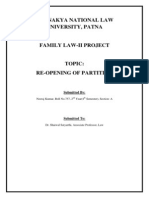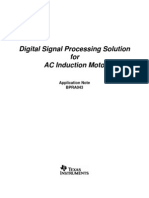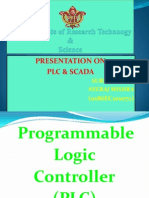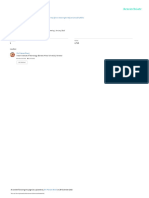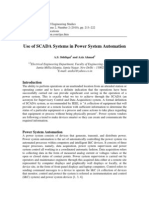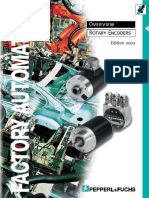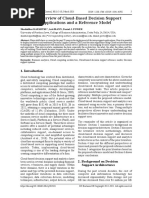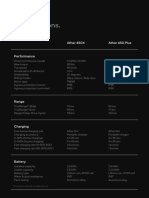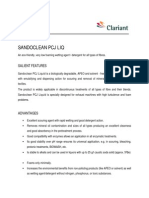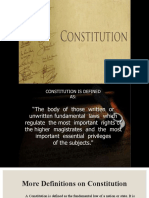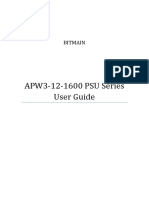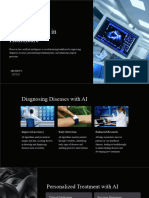Tesca Technologies Pvt. LTD.: Order Code - 52053 PC Based Analog & Digital Motor Control Trainer
Tesca Technologies Pvt. LTD.: Order Code - 52053 PC Based Analog & Digital Motor Control Trainer
Uploaded by
Goran MiljkovicCopyright:
Available Formats
Tesca Technologies Pvt. LTD.: Order Code - 52053 PC Based Analog & Digital Motor Control Trainer
Tesca Technologies Pvt. LTD.: Order Code - 52053 PC Based Analog & Digital Motor Control Trainer
Uploaded by
Goran MiljkovicOriginal Description:
Original Title
Copyright
Available Formats
Share this document
Did you find this document useful?
Is this content inappropriate?
Copyright:
Available Formats
Tesca Technologies Pvt. LTD.: Order Code - 52053 PC Based Analog & Digital Motor Control Trainer
Tesca Technologies Pvt. LTD.: Order Code - 52053 PC Based Analog & Digital Motor Control Trainer
Uploaded by
Goran MiljkovicCopyright:
Available Formats
Order Code - 52053
PC Based Analog & Digital Motor Control Trainer
Note: Specifications are subject to change.
Tesca Technologies Pvt. Ltd.
305, Taru Chhaya Nagar, Tonk Road, Jaipur-302029, India
Tel: +91-141-2724326, Mob: +91-9413330765
Email: info@tesca.in, tesca.technologies@gmail.com
Website: www.tesca.in
Order Code - 52053
PC Based Analog & Digital Motor Control Trainer
Note: Specifications are subject to change.
Tesca Technologies Pvt. Ltd.
305, Taru Chhaya Nagar, Tonk Road, Jaipur-302029, India
Tel: +91-141-2724326, Mob: +91-9413330765
Email: info@tesca.in, tesca.technologies@gmail.com
Website: www.tesca.in
Order Code - 52053
PC Based Analog & Digital Motor Control Trainer
Introduction:
Control systems are at the very heart of the technology-based world in which we live. As we grow increasingly reliant on the technology, we will
depend to greater extent on the services of maintenance / repair engineers and technicians. The proposed Motor control trainer offers a progressive
hand on approach to teaching control technology. The Motor control trainer has three levels of study, each level is based on a teaching set of control
modules. Starting with basic practical introduction to analog control, advanced analog control using three-term controller and Digital control
based on a Microprocessor system. The unit has an electro-mechanical unit containing an iron-less rotor DC motor, Analog & digital motor drive
circuitry, 3 position Eddy current brake & sensors for speed and position.Virtual Control System Lab software is included in the system to perform
all the experiments, so that dynamic results can be seen on PC , stored and analyzed.
Topics Covered :
l Analog control – an overview
l Describing and identifying system behaviour
l Time and frequency response
l Principles of feedback
l Proportional position control
l Behaviour of second order systems
l Position control with velocity feedback
l 3-Term or PID control
l Stability
l The use of computers for control
l Analog and digital interfacing
l Direct digital control
Technical Specifications :
The Analog and Digital Motor control training system consist of following modules;
DC motor control Module - DCMC
Features of the DC motor control includes:
l DC motor with on-board drive circuitry.
l Angular position indication disc, calibrated in degrees.
l Tacho-generator with switchable load resistor.
l Continuous rotation potentiometer.
l Gray-coded disc and slotted disc.
l Digital tachometer with r.p.m. readout.
l Three-position eddy current brake.
Command potentiometer module - COMPOT
The Command potentiometer provides a manually generated command signal to the control system. The calibrated indicator disc be provides an
angular position indication in degrees.
When used in conjunction with a Windows TM based PC, the Simulated control laboratory performs the following functions simultaneously:
l Monitors the reference signal from the Command potentiometer.
l Provides a PID controller with adjustable parameters.
l Generates analog/digital signals to control the DC motor module.
l Responds to analog/digital feedback signals from the DC motor module.
l Displays all control and feedback signals on the PC screen.
Simulated Control Laboratory Software - SCLS
The Virtual control laboratory software is a comprehensive teaching package that is designed specifically for use with the motor control modules.
The main screen of the Virtual control laboratory software should be divided into four sections, viz. Control reference (input) signal, Controller,
Plant & Display. Each of these may be configured independently by the user:
PC Interface module:
The PC Interface Module is designed to connect directly to the parallel port of a PC via the cable supplied. The sockets on the Interface module
allow direct connection to the inputs and outputs of the DC motor module and Command potentiometer, via 4mm leads. The PC interface module
is powered from the same power supply as the DC motor module.
Set of 36 x 4MM Interconnection Leads :
This set features lead that comprise high quality multi strand wire & terminated with a 4mm plug at each end.
Power Supply Unit - SPSU
With output voltage of 5V @ 3A, -5V @ 1A, ± 12V @ 1A with overload protection on all rails, outputs all floating from ground.
Note: Specifications are subject to change.
Tesca Technologies Pvt. Ltd.
305, Taru Chhaya Nagar, Tonk Road, Jaipur-302029, India
Tel: +91-141-2724326, Mob: +91-9413330765
Email: info@tesca.in, tesca.technologies@gmail.com
Website: www.tesca.in
Order Code - 52053
PC Based Analog & Digital Motor Control Trainer
Objective List for PC based Analog & Digital Motor Control Trainer
Analog Control – Equipment Overview
1 Locate the analog features of the DC Motor, Input Potentiometer and Interface Modules.
2 Connects together the modules for Analog control exercises.
3 Operates the software controls to drive the DC Motor and observe its behaviour.
Introduction to Control Systems
1 Outlines the objectives of control.
2 Indicates the width of application of control systems.
3 Describes what the ‘Plant Model’ means.
Time Response
1 Measure the parameters of a plant using step tests.
2 Describes the characteristics of a first order lag.
3 States the time model of the DC Motor.
Frequency Response
1 Measure the parameters of a plant using frequency tests.
2 Describes the frequency characteristics of a first order lag.
3 Explains why Bode Plots are used in preference to other frequency plots.
Principles of Feedback
1 Identifies the significant parts of a feedback control system and manipulates transfer function blocks.
2 Derives the closed loop and error transfer functions from the forward and open loop transfer functions.
3 Describes the effect of closing the loop on the steady state performance, stiffness, response time and frequency response.
Proportional Position Control
1 Accounts for the excellent steady state performance of a proportional servo position system.
2 Accounts for the poor transient performance of a proportional servo position system.
Behavior of Second Order Systems
1. Distinguishes between under-damped, critically damped and over-damped systems.
3 Relates the overshoot and damped frequency to damping factor and natural frequency.
4 Describes the form of the step response and the frequency response of a second order system.
Positional Control with Velocity Feedback
1 Sets up a servo system to respond to step inputs using proportional gain and velocity feedback.
2 Sets up a servo system to respond to ramp inputs using proportional gain and transient velocity feedback.
Three-Term or PID Control
1 Defines the purpose of Three-term Control.
2 Explains the effects of Proportional Band, Integral Action and Derivative Action.
3 Outlines how a PID controller is tuned.
Stability
1 Shows how positive feedback can occur in a negative feedback system.
2 Explains Gain Margin and Phase Margin.
3 Shows that transport lag adds phase and destabilizes a system.
The Use of Computers for Control
1 Describes the advantages and disadvantages of using computers in real-time control.
2 Defines what Direct Digital Control, Multi-loop systems and SCADA mean.
Analog Interfacing
1 Describes how computers handle numbers.
2 Explains the workings of a Digital to Analog Converter.
3 Explains the operation of a Successive Approximation analog to Digital Converter.
4 Describes the effects of amplitude and time quantization of signals.
Direct Digital Control
1 Describes how numbers are handled within a computer.
2 Relates the problems associated with digital integration.
3 Explains how digital differentiation is performed.
4 Outlines the problems arising from low resolution and slow sampling.
Digital Interfacing
1 Describes Pulse Width Modulation and other digital drive techniques.
2 Describes Gray code position measurement and other absolute and relative digital position measurement techniques.
3 Indicates the problems associated with digital speed measurements, Compares the behavior of analog and digital control systems.
Note: Specifications are subject to change.
Tesca Technologies Pvt. Ltd.
305, Taru Chhaya Nagar, Tonk Road, Jaipur-302029, India
Tel: +91-141-2724326, Mob: +91-9413330765
Email: info@tesca.in, tesca.technologies@gmail.com
Website: www.tesca.in
You might also like
- PMDG Boeing 737 ChecklistDocument2 pagesPMDG Boeing 737 Checklistmonmondayo100% (6)
- Family Law Project Re-Opening of PartitionDocument15 pagesFamily Law Project Re-Opening of PartitionAnwishikha75% (16)
- DC Motor Speed C BcontrolDocument6 pagesDC Motor Speed C BcontrolRoger RozarioNo ratings yet
- Digital Signal Processing Solution For AC InductionDocument27 pagesDigital Signal Processing Solution For AC InductionWenkatWenkatNo ratings yet
- Project Synopsis Digital Controller Using Matlab: Deptt. of Electronics and InstrumentationDocument9 pagesProject Synopsis Digital Controller Using Matlab: Deptt. of Electronics and InstrumentationSaumya TripathiNo ratings yet
- An Overview of PLC Based Control Panel System For External Plunge Grinding Machine and CNC MachineDocument3 pagesAn Overview of PLC Based Control Panel System For External Plunge Grinding Machine and CNC MachineIJMERNo ratings yet
- Mydcmotorcontrol: Applying Control Theory To A Real DC Motor System in An Open-Loop ConfigurationDocument5 pagesMydcmotorcontrol: Applying Control Theory To A Real DC Motor System in An Open-Loop ConfigurationnorickespinosNo ratings yet
- DC Servomotor-Based Antenna Positioning Control System Using PidDocument15 pagesDC Servomotor-Based Antenna Positioning Control System Using PidSharanya Shree SubbaraoNo ratings yet
- Star Delta ConversionDocument17 pagesStar Delta Conversionkrishnaprasadkhanal222No ratings yet
- Result PPRDocument5 pagesResult PPRMayuri Chauray-shindeNo ratings yet
- Control & InstrumentationDocument12 pagesControl & Instrumentationsabdo aryaNo ratings yet
- Speed Control of BLDC Motor Using IPM and Micro 2812 Ver.2.0Document41 pagesSpeed Control of BLDC Motor Using IPM and Micro 2812 Ver.2.0subbanna100% (1)
- PLC ScadaDocument30 pagesPLC ScadaNeeraj Mishra100% (1)
- PID Controller Based DC Motor Speed ControlDocument4 pagesPID Controller Based DC Motor Speed ControlEditor IJRITCCNo ratings yet
- PLC & HMI Interfacing For AC Servo Drive: Naveen Kumar E T.V.Snehaprabha Senthil KumarDocument5 pagesPLC & HMI Interfacing For AC Servo Drive: Naveen Kumar E T.V.Snehaprabha Senthil KumarNay Ba LaNo ratings yet
- Monu PDFDocument6 pagesMonu PDFMonurajanNo ratings yet
- Course Code: CSE360 Course Title: Computer Architecture Section: 02 Project Title: Suggest and Design A Minimal CPU Group NumberDocument7 pagesCourse Code: CSE360 Course Title: Computer Architecture Section: 02 Project Title: Suggest and Design A Minimal CPU Group NumberrimonNo ratings yet
- Lecture Notes For DSP Control For BLDC Motor DriveDocument34 pagesLecture Notes For DSP Control For BLDC Motor DriveRavi ArunNo ratings yet
- Digital Control and PID Control of Industrial Processes AssignmentDocument18 pagesDigital Control and PID Control of Industrial Processes AssignmentrodneymandizvidzaNo ratings yet
- Long Report ControlDocument39 pagesLong Report Controlaimanfarid1710No ratings yet
- Speed Control of DC Motor Using Pid Controller BasedDocument16 pagesSpeed Control of DC Motor Using Pid Controller Basedayesha amjadNo ratings yet
- Programmable Logic ControllerDocument15 pagesProgrammable Logic ControllerMukesh Kumar BeheraNo ratings yet
- "Programmable Logic Controller": Degree of Bachelor of TechnologyDocument42 pages"Programmable Logic Controller": Degree of Bachelor of TechnologyVikas VermaNo ratings yet
- Design and Implementation of PLC-Based Monitoring Control System For Three-Phase Induction Motors Fed by PWM InverterDocument8 pagesDesign and Implementation of PLC-Based Monitoring Control System For Three-Phase Induction Motors Fed by PWM InverterPrajyot KhairkarNo ratings yet
- Industrial Automation System PDFDocument10 pagesIndustrial Automation System PDFCIMUT125No ratings yet
- PLC ScadaDocument4 pagesPLC ScadaRajeshNo ratings yet
- Boiler Automation PDFDocument5 pagesBoiler Automation PDFHarshada DeokateNo ratings yet
- Remote Control Based Ac or DC Motor Speed Control System - 1ST ReviewDocument15 pagesRemote Control Based Ac or DC Motor Speed Control System - 1ST ReviewAnonymous Clyy9NNo ratings yet
- DC Motor Speed Control Using PID Controller in Lab View: January 2015Document5 pagesDC Motor Speed Control Using PID Controller in Lab View: January 2015EngidNo ratings yet
- Microprocessor Based Digital PID Controller For Speed Control of D.C. MotorDocument6 pagesMicroprocessor Based Digital PID Controller For Speed Control of D.C. MotorSwapnica GarreNo ratings yet
- TP Ri MansourDocument9 pagesTP Ri Mansourm2zcopieNo ratings yet
- MCT 332 Industrial Automation (Lec. 3)Document38 pagesMCT 332 Industrial Automation (Lec. 3)Mohamed SobhyNo ratings yet
- Direct Digital ControlDocument6 pagesDirect Digital Controlkevindavies276No ratings yet
- Practical Controller Design For DummiesDocument91 pagesPractical Controller Design For DummiesManraj Tatla100% (1)
- Dyna DCMC Curriculam ManualDocument203 pagesDyna DCMC Curriculam ManualDevSinghNo ratings yet
- Mitsubishi Melsec PLC Ladder Logic ApplicationDocument215 pagesMitsubishi Melsec PLC Ladder Logic ApplicationAmon Amarth100% (1)
- Paper UksimDocument6 pagesPaper Uksimsattanic666No ratings yet
- Digital and Programmable Logic CircuitsDocument42 pagesDigital and Programmable Logic Circuitsengheshamwael18No ratings yet
- Use of SCADA Systems in Power System AutomationDocument10 pagesUse of SCADA Systems in Power System AutomationKamlesh KumarNo ratings yet
- Industrial Automation System: AbstractDocument6 pagesIndustrial Automation System: AbstractEngr Nayyer Nayyab MalikNo ratings yet
- PLC & SCADA Training ReportDocument44 pagesPLC & SCADA Training Reportneeraj meena100% (2)
- Introduction To PLC Controllers For Beginners (Nebojsa Matic)Document69 pagesIntroduction To PLC Controllers For Beginners (Nebojsa Matic)Nookiez ChaiyaditNo ratings yet
- 2 MarksDocument5 pages2 MarksPriya DharshiniNo ratings yet
- Transfer Function Analysis and Performance Evaluation of An RPM Measurement Circuit For Gear DC MotorsDocument12 pagesTransfer Function Analysis and Performance Evaluation of An RPM Measurement Circuit For Gear DC Motorsmuhammadabdullahrana912No ratings yet
- Ijctt-Microcontroller Based Servo Motor Control SystemDocument3 pagesIjctt-Microcontroller Based Servo Motor Control Systemnavyarajeswari911No ratings yet
- PLC Simulation ReportDocument62 pagesPLC Simulation ReportAsraful Goni NirabNo ratings yet
- Study Material Mechatronics and Automatiom - Part IiiDocument133 pagesStudy Material Mechatronics and Automatiom - Part Iiijayakrishnan psNo ratings yet
- 207 00 Analog and Digital Motor Control Teaching SetDocument2 pages207 00 Analog and Digital Motor Control Teaching SetDavid de Almeida FiorilloNo ratings yet
- DC Motor Speed Control Using PID Controller in Lab ViewDocument5 pagesDC Motor Speed Control Using PID Controller in Lab ViewFlavioNo ratings yet
- Boiler Control Using SCADADocument9 pagesBoiler Control Using SCADAAdarsh Sunkad0% (1)
- Digital Control Engineering Chapter 1Document8 pagesDigital Control Engineering Chapter 1Ishmayne Shawarrma100% (1)
- Fault Detection and Protection of InductionDocument14 pagesFault Detection and Protection of InductionYashprit BediNo ratings yet
- DC Motor Position Control Using Fuzzy Proportional-Derivative Controllers With Different Defuzzification MethodsDocument11 pagesDC Motor Position Control Using Fuzzy Proportional-Derivative Controllers With Different Defuzzification MethodsLele glosyNo ratings yet
- Control Systems: Piu Ghosh Instrumentation and Control DepartmentDocument42 pagesControl Systems: Piu Ghosh Instrumentation and Control Departmentpiu_ghosh9966100% (1)
- Training Program On Programmable Logic ControllerDocument28 pagesTraining Program On Programmable Logic ControllerHimanish GuptaNo ratings yet
- PLC QuestionsDocument17 pagesPLC QuestionsbahyNo ratings yet
- CTE 441 Part 2Document21 pagesCTE 441 Part 2aulelunenNo ratings yet
- LPC2148 Finger Print ProjectDocument55 pagesLPC2148 Finger Print Projectbvkarthik2711No ratings yet
- ISA Certified Automation Professional (CAP) Associate: Certification Exam Prep: 500 Practice Exam Questions and ExplanationsFrom EverandISA Certified Automation Professional (CAP) Associate: Certification Exam Prep: 500 Practice Exam Questions and ExplanationsNo ratings yet
- High Speed Multichannel Impedance Measuring System: Acta ImekoDocument6 pagesHigh Speed Multichannel Impedance Measuring System: Acta ImekoGoran MiljkovicNo ratings yet
- ELE604 Student GuideDocument344 pagesELE604 Student GuideGoran MiljkovicNo ratings yet
- Lab1 111 PDFDocument16 pagesLab1 111 PDFGoran MiljkovicNo ratings yet
- Labview Fpga Based Noise Cancelling Using The Lms Adaptive AlgorithmDocument4 pagesLabview Fpga Based Noise Cancelling Using The Lms Adaptive AlgorithmGoran MiljkovicNo ratings yet
- Sensors: A Self-Timed Multipurpose Delay Sensor For Field Programmable Gate Arrays (Fpgas)Document15 pagesSensors: A Self-Timed Multipurpose Delay Sensor For Field Programmable Gate Arrays (Fpgas)Goran MiljkovicNo ratings yet
- Triaxis® Position Sensor: Product Code Temperature Code Package Code Option Code Packing Form CodeDocument48 pagesTriaxis® Position Sensor: Product Code Temperature Code Package Code Option Code Packing Form CodeGoran MiljkovicNo ratings yet
- 06 Displacementvelocity PDFDocument103 pages06 Displacementvelocity PDFGoran MiljkovicNo ratings yet
- Linear Hall Effect Sensor Angle Measurement Theory, Implementation, and CalibrationDocument26 pagesLinear Hall Effect Sensor Angle Measurement Theory, Implementation, and CalibrationGoran MiljkovicNo ratings yet
- Digital Measurement of Frequency With Linear Interpolation in Dynamic StatesDocument4 pagesDigital Measurement of Frequency With Linear Interpolation in Dynamic StatesGoran MiljkovicNo ratings yet
- Microcontroller Cores ForDocument8 pagesMicrocontroller Cores ForGoran MiljkovicNo ratings yet
- Period Measurement With A Counter: TutorialDocument2 pagesPeriod Measurement With A Counter: TutorialGoran MiljkovicNo ratings yet
- Ordering Information: Related Products Related DocumentsDocument6 pagesOrdering Information: Related Products Related DocumentsGoran MiljkovicNo ratings yet
- Specialised Tachometric Measuring System On The Basis ofDocument7 pagesSpecialised Tachometric Measuring System On The Basis ofGoran MiljkovicNo ratings yet
- Position EncodersDocument12 pagesPosition EncodersGoran MiljkovicNo ratings yet
- Incremental Motion Control of Synchronous Reluctance Motor Via Multisegment Sliding Mode Control MethodDocument8 pagesIncremental Motion Control of Synchronous Reluctance Motor Via Multisegment Sliding Mode Control MethodGoran MiljkovicNo ratings yet
- Motor Position Control Lab: University at BuffaloDocument12 pagesMotor Position Control Lab: University at BuffaloGoran MiljkovicNo ratings yet
- 133: Gobion Manor, Monmouthshire, Watching Brief, APAC LTDDocument41 pages133: Gobion Manor, Monmouthshire, Watching Brief, APAC LTDAPAC LtdNo ratings yet
- SMA-2016-17 Modified OK Final PRINT (5 Files Merged)Document193 pagesSMA-2016-17 Modified OK Final PRINT (5 Files Merged)manoj186186No ratings yet
- Cooling Water Treatment and Analysing: Operating InstructionDocument7 pagesCooling Water Treatment and Analysing: Operating Instructionamin32No ratings yet
- Eapp Q4 SLK 1 A Concept PaperDocument17 pagesEapp Q4 SLK 1 A Concept Paperlovely dacanayNo ratings yet
- GE 00003287 Instruction Manuals and User GuidesDocument52 pagesGE 00003287 Instruction Manuals and User GuidesJUAN RAMON ADAMENo ratings yet
- SSD - BCDocument14 pagesSSD - BCAndreea UniNo ratings yet
- Waiver of Rights: Schools Division Office I PangasinanDocument3 pagesWaiver of Rights: Schools Division Office I PangasinanCath ZMNo ratings yet
- PSFK ReportDocument72 pagesPSFK ReportAdam C. Passarella0% (1)
- Slay Your Money GuideDocument13 pagesSlay Your Money Guidevaleryaa11No ratings yet
- Bikol Reporter August 6 - 12, 2017 IssueDocument8 pagesBikol Reporter August 6 - 12, 2017 IssueBikol ReporterNo ratings yet
- P Nucleo Ihm03Document6 pagesP Nucleo Ihm03madhushmanuNo ratings yet
- Ather450X SpecificationsSheetDocument4 pagesAther450X SpecificationsSheetNitin DevnaniNo ratings yet
- MD MCSR2022-11 S004205Document417 pagesMD MCSR2022-11 S004205Alexei GusanNo ratings yet
- A Forum With H.E. Yuji Iwasawa "The Future of ICJ: Prospects and Challenges"Document35 pagesA Forum With H.E. Yuji Iwasawa "The Future of ICJ: Prospects and Challenges"AJ ArugayNo ratings yet
- Alpha Software Manual Versb English PDFDocument44 pagesAlpha Software Manual Versb English PDFTamás LakatosNo ratings yet
- San Do Clean PCJ LiquidDocument2 pagesSan Do Clean PCJ Liquidriqpwri112100% (1)
- Sociolinguistic Variation in Urban Linguistic LandscapesDocument189 pagesSociolinguistic Variation in Urban Linguistic Landscapesy22pmrpj57No ratings yet
- 311044module-12 CrwillDocument54 pages311044module-12 Crwillbaruarishabh2003No ratings yet
- International Business: by Charles W.L. HillDocument24 pagesInternational Business: by Charles W.L. HillAshraful IslamNo ratings yet
- 4 General Membership Meeting: September 7, 2022 4:30pm Batangas Country Club, Kawayan HallDocument59 pages4 General Membership Meeting: September 7, 2022 4:30pm Batangas Country Club, Kawayan HallWesley CorderoNo ratings yet
- INTEL Rapid StorageDocument17 pagesINTEL Rapid StorageAnonymous WKf8JCmtNo ratings yet
- APW3!12!1600 User GuideDocument8 pagesAPW3!12!1600 User GuidejuliogiorgiNo ratings yet
- HCI4F 311 1P TD EN - Rev - A PDFDocument9 pagesHCI4F 311 1P TD EN - Rev - A PDFRenzo zuñiga ahonNo ratings yet
- Project Report ON A Study On Solid Waste Management Environmental ScienceDocument37 pagesProject Report ON A Study On Solid Waste Management Environmental ScienceSushank pandeyNo ratings yet
- The Rise of AI in HealthcareDocument7 pagesThe Rise of AI in HealthcaresruthisnamboodiriNo ratings yet
- CSKHKPV PalampurDocument15 pagesCSKHKPV PalampurBunty SangralNo ratings yet
- Product Design and Development PDFDocument3 pagesProduct Design and Development PDFAbdullahNo ratings yet

